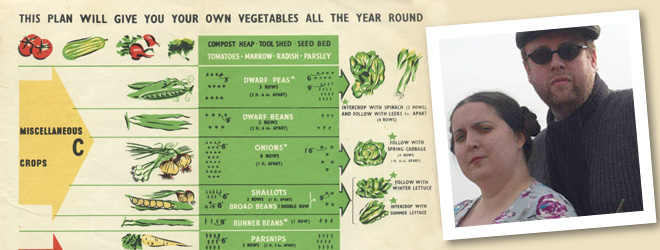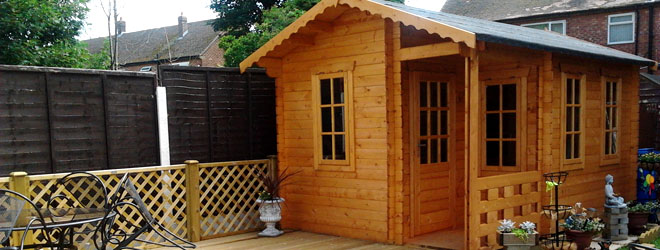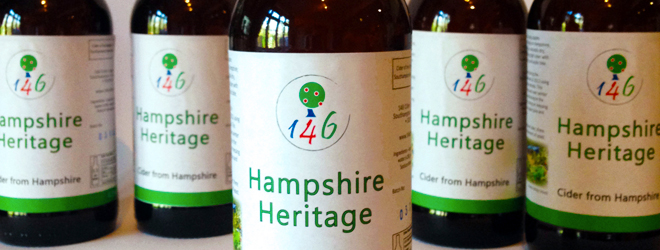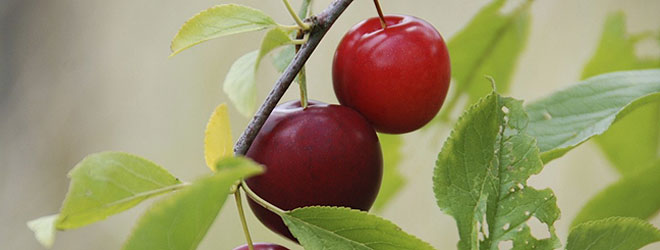Andrew Oldham is creating a wartime veg patch with his family at their home in the Pennines. We found out more about their historical adventure…
Your website, Life on Pig Row, details your experience of living off your garden in the Pennines. Tell us a little bit about Pig Row.
Pig Row is the old name for the cottages we live in the West Riding of Yorkshire. Carol, I and Little D live in this small hamlet on an old turnpike road that only sees the hustle and bustle of tractors, horses and the occasional group of walkers. If you walked past our house you wouldn’t realise its secret, that sitting behind the stone cottage is a ¼ acre of land stretching up a hillside. This means we do extreme growing – growing at 1,330ft above sea level throws up its own problems but taking on a garden that had been partially unused for 40 years was another problem entirely. Back in 2009, when we first viewed the house, Carol was six months pregnant and we knew before we even walked through the door that we’d buy it. It was the views. We can see out over several counties and the Pennines run through us and around Pig Row giving us spectacular views. If you can see the horizon here and clouds, it means rain is coming, if you can see nothing, it means you’re in a rain cloud. That summer day when we first saw the house it was blue sky as far as the eye could see.
The house itself needs work, and this is something we are starting to chronicle in the blog along with the problems we have had with green technology. The garden when we first viewed it was swamped by laurels and brambles; it stopped 60 feet from our back door. It was disappointing but not surprising in an area that is dominated by mill cottages. It was Carol who saw a narrow path running through the laurels, and even at 6 months, she pushed through the laurel hedge that blocked our way. Beyond was like walking into a forgotten garden, an abandoned place in time, for beyond the laurel hedge was another 300 feet of garden untouched for many years. The estate agent showing us around assumed that the garden ended after 60 feet and we never did share with him what we found beyond the laurel. That winter we moved in and in 2011 we started work on creating a garden that would feed us.
This year you’re turning back time and recreating a wartime garden, growing veg that was familiar during the Second World War. How did the idea come about?
We just see the idea as an extension of what we do at Pig Row. We grow to eat, we grow to survive, we make do and mend. The very thought of how much we import into the UK leaves me feeling cold. It seems we have little or no idea where our food comes from. If we don’t have lawns then we have block paving. If we don’t have block paving we have decking and that is a waste of a resource we all rely on, soil. Concrete leaves me cold. I suspect this anger at our inability to see how important our food production is led us to the height of domestic food production in the UK, which was the Second World War. Did you know that from 1942-43 that allotments alone produced one million tons of food? We all can grow food. I would rather see concrete swamped by peas and beans, balconies burgeoning with lettuces and pots by the front door full of carrots. We can all do our bit. We wanted to show by looking back at the Second World War, by following Dig For Victory Leaflet No1: Grow for Winter as well as Summer (published around 1940 and distributed throughout 1941) you could grow for all seasons.
We are doing it differently though and have shrunk down the plot sizes to show that you can produce a little if not a lot all year round in the average front and back garden. We won’t though reach for pesticides; we are organic at Pig Row. We want more people to grow food beside their flowers, and rather than see gardens as a problem, to see them as a solution in this time of economic flux. I hear too many times people say that they tried to garden by chucking some seeds or bedding into their garden and gave up when nothing happened or the pansies died. We hope over the next year people will see how we do it (on the blog, at our Facebook Page and via twitter, @lifeonpigrow), get involved, grow their own in pots, in their front and back gardens and in strips of ground forgotten in every nook and cranny.
Did you have much trouble tracking down vegetable seeds from the era?
We did, we ended up finding varieties that ranged from the Victorian era to just after the War. Remember rationing did not end to the 1950s, and we did not stop growing food for many years after. In the end we were helped by Thomas Etty and Pennard Plants. We owe a lot to Thomas Etty who took time out to help us find varieties in their list that would fit the brief, and in some cases, helped us decipher some of the terms and names from the era. We also found that some varieties we wanted to grow were extinct, such as Salford Black Runner Beans (though we have been contacted since by someone who thinks they may have them, passed down through her family) and we would have grown Champion of England peas but were misled into believing these too were gone. Since I wrote The Guardian article on the Wartime Garden many people have come forward directing me to stockists of it and that is a great thing. We need people to share stockists of heritage and rare seeds; we need to seek out the variety that will do the job for us.
Why do you think it’s important to grow heritage vegetables?
Taste. You may think a lettuce is just a lettuce. You may think all carrots are orange. You may simply believe that these all taste the same. We don’t want uniform crops at Pig Row, we are not a supermarket, we are a real family. We want vegetables that bolt, we want the seed. We need to save seed to sow again. Heritage varieties run in their hundreds just for lettuce alone. Carrots can be found in every shape and colour. Your vegetable plot doesn’t just have to be green and uniform. We can only do this by embracing heritage varieties; we won’t allow F1 varieties at Pig Row. For us they serve no sustainable purpose. Frankly I’d rather have a Fat Lazy Blonde than an Iceberg lettuce. Heritage seeds and vegetables were sown by our great grandparents, and if it was good enough for them why do we think we deserve better? There are great vegetables out there, there is a cabbage for everyone, there is a lettuce to suit anyone’s taste, peas to make your mouth water and beans to beef up stews. There is more variety and taste in heritage tomatoes alone than can be found in a supermarket vegetable aisle.
Will you be reviving wartime recipes too?
Yes, we will attempt to revive mock bananas (parsnips) and much more but we can’t really decide until we see what is doing well. I have been told to put a board up in the kitchen to tell Carol what is ready to eat and she will reach for the recipes. We want to preserve as much as we can too and take advantage of living in the countryside from foraging to bartering.
We’ve heard of ingenious tales of turning those vegetables into booze, such as a not-so-appetising sounding ‘potato beer’. Will your voyage of discovery go this far?
No, we’ve had potato beer (it was awful and gives you wind) and frankly beer wasn’t rationed during the War and won’t be this time round. We do have a rhubarb patch though, and as this is established and high in vitamins, we will be turning some of it into schnapps for the winter, for purely medicinal reasons around Christmas time.
Are there any veg on your list you’re particularly looking forward to sampling?
Yes, I am looking forward to cooking Shetland Black potatoes again. They make the foulest looking chips ever but they are also the tastiest. I am keen to try my own parsnips as I have never been keen on them and I want to be a convert.
And any you’re not…?
I abhor swede but have been inundated by people who hate it too but have found new ways of cooking it or, in one case, making it into wine. It is this idea of preserving our plot that interests me the most and making sure that nothing goes to waste.
Any plans to revisit another bygone age in future?
I think living through 1943 again will give us the taste to look to the past for ideas. We would like to reproduce a working Victorian Walled Garden at some point, preferably in partnership with someone who owns one. So few are left and we should protect them, as we should protect our food heritage, and the Wartime Garden is about that. However, we do not fancy a return to serfdom.
Keep up to date with Andrew and Carol’s progress at their website, Life on Pig Row, here








We also try to grow only heritage varieties on out plot. We also try to grow seed as well. Stirling Stuff!